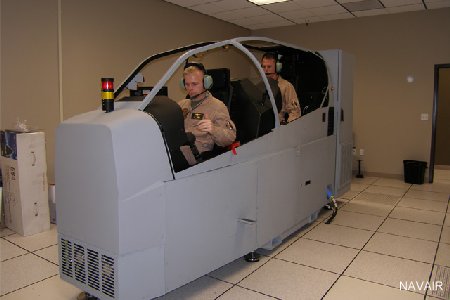
US Naval Air Systems Command (NAVAIR), December 27, 2011 - PATUXENT RIVER, Md. -- Four cockpit procedures trainers (CPTs), located at the Center for Naval Aviation Technical Training (CNATT) and the Marine Aviation Training Systems Site (MATSS) Marine Corps Air Station (MCAS) Camp Pendleton, Calif., were declared ready for training Sept. 22.
The trainers, two UH-1Y Huey and two AH-1Z Cobra devices, provide pilots and maintainers general skills and basic operations training prior to being introduced to the full mission simulator or the composite maintenance trainers.
New AH-1Z and UH-1Y helicopters are arriving on Marine Corps flightlines on a regular schedule. The CPTs assist seasoned aircrew and maintainers with “differences” training. Users familiarize themselves with the differences between the old and new airframes, allowing them to get acquainted with the new aircraft while maintaining flight schedules.
“The CPTs are a valuable training option for the fleet. They provide pilots and maintainers with a readily available device to obtain basic qualifications and familiarization training without tying up fleet assets,” said Capt. John Feeney, Naval Aviation Training Systems (PMA-205) program manager. “The CPTs can be used to offload some of the training tasks from the full mission simulator, thereby lowering costs and maximizing training efficiency.”
According to Mark Elliott, PMA-205 H-1 training integrated product team (IPT) lead, the delivery of these trainers is the culmination of three years’ work for a capability that did not previously exist in the Marine Corps H-1 community.
"The CPT's role is to support AH-1Z and UH-1Y training. Having a device, or a suite of devices, at each step along the continuum ensures we maximize the efficiency of training received by the Marine Corps H-1 community as we transition to the new aircraft configurations," Elliott said.
In addition to “differences” training, aircrew and maintainers can receive initial aircraft exposure to give hands-on experience and training, aiding in faster assimilation later in the learning process.
“It seems like a natural progression, step one is the classroom environment with instruction; pilots and maintainers then get acquainted with the cockpit in the CPT and finally they move on to actual aircraft,” said Staff Sgt. Blake Minckler, CNATT, maintenance control chief,
Individual pilots and maintainers requiring basic qualifications can also schedule time in the CPT. This on-the-job training caters to individual needs without interrupting daily flight schedules, Minkler said.
The trainers, two UH-1Y Huey and two AH-1Z Cobra devices, provide pilots and maintainers general skills and basic operations training prior to being introduced to the full mission simulator or the composite maintenance trainers.
New AH-1Z and UH-1Y helicopters are arriving on Marine Corps flightlines on a regular schedule. The CPTs assist seasoned aircrew and maintainers with “differences” training. Users familiarize themselves with the differences between the old and new airframes, allowing them to get acquainted with the new aircraft while maintaining flight schedules.
“The CPTs are a valuable training option for the fleet. They provide pilots and maintainers with a readily available device to obtain basic qualifications and familiarization training without tying up fleet assets,” said Capt. John Feeney, Naval Aviation Training Systems (PMA-205) program manager. “The CPTs can be used to offload some of the training tasks from the full mission simulator, thereby lowering costs and maximizing training efficiency.”
According to Mark Elliott, PMA-205 H-1 training integrated product team (IPT) lead, the delivery of these trainers is the culmination of three years’ work for a capability that did not previously exist in the Marine Corps H-1 community.
"The CPT's role is to support AH-1Z and UH-1Y training. Having a device, or a suite of devices, at each step along the continuum ensures we maximize the efficiency of training received by the Marine Corps H-1 community as we transition to the new aircraft configurations," Elliott said.
In addition to “differences” training, aircrew and maintainers can receive initial aircraft exposure to give hands-on experience and training, aiding in faster assimilation later in the learning process.
“It seems like a natural progression, step one is the classroom environment with instruction; pilots and maintainers then get acquainted with the cockpit in the CPT and finally they move on to actual aircraft,” said Staff Sgt. Blake Minckler, CNATT, maintenance control chief,
Individual pilots and maintainers requiring basic qualifications can also schedule time in the CPT. This on-the-job training caters to individual needs without interrupting daily flight schedules, Minkler said.
See also |
UH-1Y Venom in




